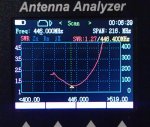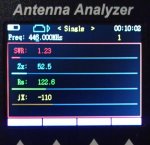NC1
Member
Aha, the screen shot helps tremendously.
Maybe I can explain this for you, I hope it goes from my head to my hands in a way you understand.
In picture #2, where you are sweeping the antenna from 132 to 173, the analyzer told you the antenna loves the SWR of 1.27:1 at 162.800MHz. The different color vertical dotted line in the center of the screen is the 142.000 MHz you were looking for. Since the SWR is flatlined at that frequency at the top (SWR 19.9), your antenna is terrible for the VHF Ham band. Basically, the antenna is more suited for NOAA Weather.
In picture #1, 151.500MHz is the vertical dotted line in the center of the display. The location of 144.500MHz is indicated by the white triangle at the bottom, with the SWR of 19.9:1 for that frequency showing at the upper right in red numbers. The other triangle at the bottom of the dip is 162.800MHz even though the frequency is not shown.
The last picture is just the readout of the final result of that antenna tested at 144.400MHz, which is not good. The only result that is fairly decent there is the Zx.
Hope that helps.
Maybe I can explain this for you, I hope it goes from my head to my hands in a way you understand.
In picture #2, where you are sweeping the antenna from 132 to 173, the analyzer told you the antenna loves the SWR of 1.27:1 at 162.800MHz. The different color vertical dotted line in the center of the screen is the 142.000 MHz you were looking for. Since the SWR is flatlined at that frequency at the top (SWR 19.9), your antenna is terrible for the VHF Ham band. Basically, the antenna is more suited for NOAA Weather.
In picture #1, 151.500MHz is the vertical dotted line in the center of the display. The location of 144.500MHz is indicated by the white triangle at the bottom, with the SWR of 19.9:1 for that frequency showing at the upper right in red numbers. The other triangle at the bottom of the dip is 162.800MHz even though the frequency is not shown.
The last picture is just the readout of the final result of that antenna tested at 144.400MHz, which is not good. The only result that is fairly decent there is the Zx.
Hope that helps.



